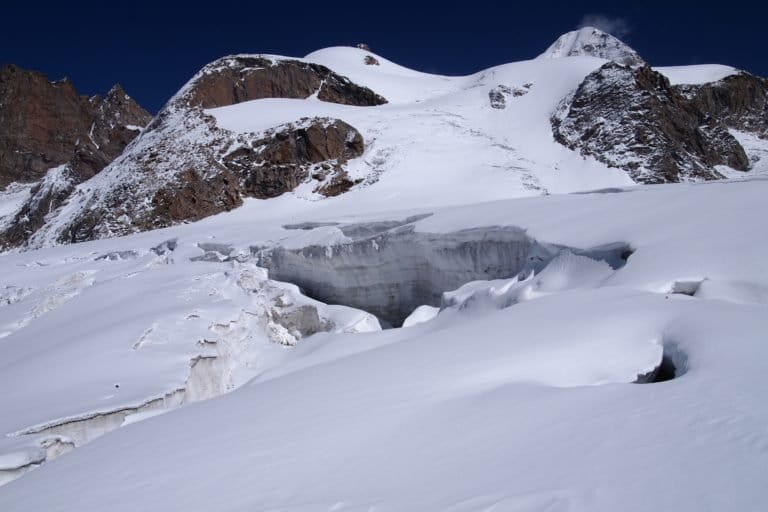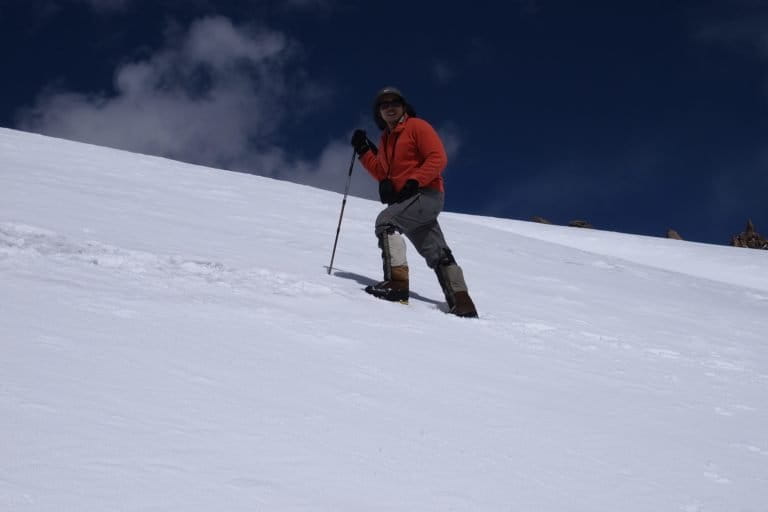- Snowmelt is the largest contributor to annual runoff for the Chhota Shigri catchment in the western Himalayas, followed by rain and ice melt.
- In the years when the glacier mass balance was negative, which includes the latest period 2001-2016, glacial ice melt contribution increased due to greater exposure to solar radiation.
- Climate change in the region is resulting in higher temperatures and reduced snowfall, both of which favor greater glacial ice melt.
Snowmelt is the largest contributor to average annual runoff for the Chhota Shigri glacier catchment in the western Himalayas, finds a team of researchers from India and France in a recent study that used extensive field data that is scarcely available due to the harsh conditions in the region. It also reveals that during the periods when the glacier mass balance (the difference between accumulation and ablation or melting) was negative, ice melt contributions surged.
Snow and ice in the Himalayan-Karakoram region are vital to the freshwater supplies of around 800 million people living in the Indus, Ganges, and Brahmaputra river basins. As a result, glaciologists and scientists are concerned about how a changing climate in the region will affect runoff from glacial ice melt and snowmelt.
Researchers in this study looked at how regional climate in the Chhota Shigri catchment has affected the contributions of snow and ice melt to river runoff, which in turn will guide decisions on how water resources are managed in the region.

Fieldwork is challenging
Since fieldwork is “labourious, risky and expensive” explains Mohd. Farooq Azam, assistant professor at the Indian Institute of Technology in Indore and lead author of the study, researchers select a few glaciers to study in detail and Chhota Shigri is one of the benchmark glaciers in the Himalayas where data has been collected since 2003.
Located in Lahaul valley of Himachal Pradesh, Chhota Shigri is one of the best-studied glaciers in the Himalayan region. Runoff from the Chhota Shigri catchment contributes to the Chandra River, one of the tributaries of the Indus River Basin.
Field measurements are carried out twice a year in June and October where researchers stay for about 15 days at each visit at altitudes ranging from 3,800m (base camp below glacier) to 5,500m, Azam revealed. Conditions are tough because atmospheric pressure drops at high altitudes and so at 5,500m so one gets only half of the oxygen compared with that at sea level, added Azam, who has been working at Chhota Shigri since 2008.

“This paper demonstrates the importance of the year-to-year variability in snow accumulation and snowmelt in protecting or exposing the glacier to the long-term trend of increasing temperature,” said Ian Holman, professor of Integrated Land and Water Management at Cranfield Water Science Institute, United Kingdom, who was not involved in the study.
“However, whilst increasing temperatures due to climate change are likely to lead to continued mass wastage of the glacier, climate change projections of changes in precipitation (snow and rainfall) are very uncertain (unlike the temperature projections), making the long-term evolution of the glacier uncertain.”
Rise in ice melt when glacier mass balance negative
For the study, the team developed a glacio-hydrological model to reconstruct glacier-wide mass balances and runoff contributions from 1969 to 2016 for the small Chhota Shigri catchment (34.7 square kilometers), which is 47 percent glacierised. They used daily temperature and precipitation records from the meteorological stations at Bhuntar Observatory (1092 metres above sea level), glacier base camp (3850 m a.s.l.) and glacier side moraine (4863m a.s.l.).
The findings showed that snow accumulation during both winter and summer is among the main climate driver and controls glacier-wide mass balances along with catchment-wide runoff. Snowmelt, which occurs largely from May to October, was the largest contributor to total average annual runoff at 63 percent whereas ice melt and rain were 17 and 20 percent respectively. Total runoff peaked during the month of August.
Overall, the glacier mass wastage was moderate during the study period. Three distinctive periods emerged depending on whether the glacier mass balance was stable or negative. During period I (1969-1985) and III (2001-2016) Chhota Shigri had a negative mass balance, which was lowest during the latest period, while it was stable during period II (1986 to 2000).
“In the case of dry years, glacier mass wastage is high and ice melt becomes very important,” said Azam. “It acts like your money in a bank that you use to regulate your expenses in case of salary delay or less salary,” he elaborated.
When the mass balance of the glacier is negative, ice melt rises strongly to the detriment of snowmelt, particularly in late July and the beginning of August, the authors noted. This, they explained, is because of the rapid decay of snow cover, which is likely associated with a vertical migration of the snow line, leaving much of the glacier exposed with bare ice. As a result, the absorption of solar radiation by the ice is enhanced and this fosters ice melt.
During period III (2001-2016), “the temperatures were higher that resulted in more melting and less snow falls” and “overall precipitation was also less over this period,” noted Azam.
“Accelerated melt is a direct result of climate change,” said Azam, explaining that the climate in this region is changing in two ways: “temperatures are rising and precipitations are reducing.” Both of these changes favor more ice melt.
Richard Armstrong, a senior research scientist at the National Snow and Ice Data Center, U.S., finds the study “very impressive,” adding that the team has “taken full advantage of just about every data source to calibrate their model.”
In his study, published in 2018, Armstrong and his colleagues looked at melt water contributions in full river basins above 2000 m. For the Indus basin, they showed the contributions were “23% for rain, 73% for seasonal snow, and 3% for glacier ice melt.”
Armstrong observes that in the present study “while snowmelt is the largest contributor (just as we found), when there are years of less snow accumulation that minimal snow cover causes the glacier ice to be exposed sooner in the melt season and thus there is more ice melt than typical for the long-term average.”
He further noted in that in the present study, glacier ice melt is higher compared with his findings. This “makes sense since they were looking only at the sub-basin that contains the Chhota Shigri glacier where of course the glacier ice melt would have a larger proportional contribution,” he reasoned. Armstrong’s study also found maximum glacier melt in August.
Azam stressed that the “next step is to understand the precipitation variability in mountainous regions because it was the biggest challenge in this study—similar to other studies in Nepalese Himalaya—and development of large-scale glacio-hydrological models which are fed with enough field observations.”
“There are several regions such as Zanskar, Ladakh, Karakoram regions where such studies are completely missing,” he pointed out. “We need more scientific manpower and research funds from the government to start such studies in other regions of the Indian Himalayas.”
CITATION
Azam, M.F., Wagnon, P., Vincent, C., Ramanathan, A.L., Kumar, N., Srivastava, S., Pottakkal, J.G., Chevallier, P. (2019). Snow and ice melt contributions in a highly glacierized catchment of Chhota Shigri Glacier (India) over the last five decades. Journal of Hydrology, 574, 760-773. doi.org/10.1016/j.jhydrol.2019.04.075
